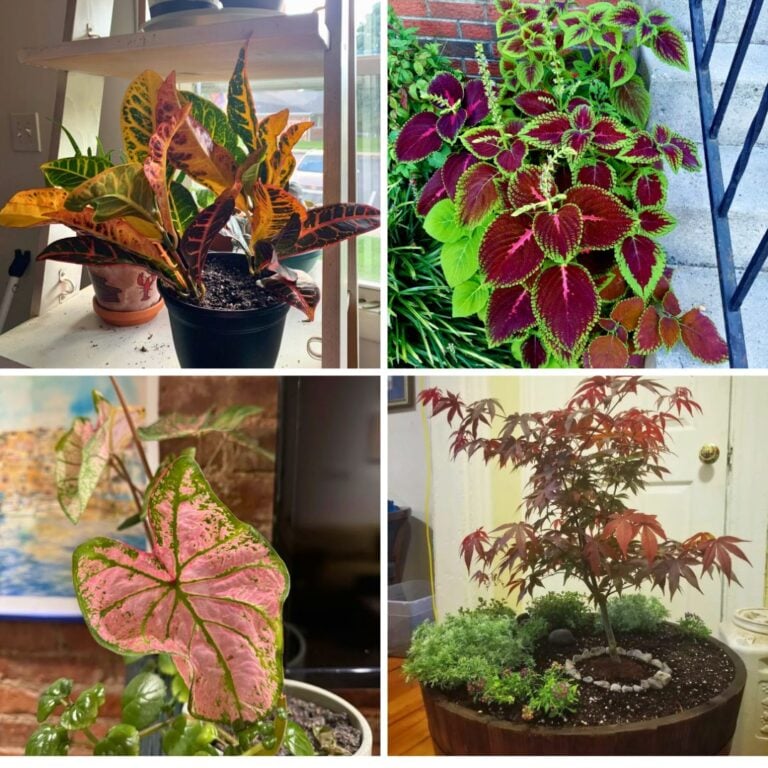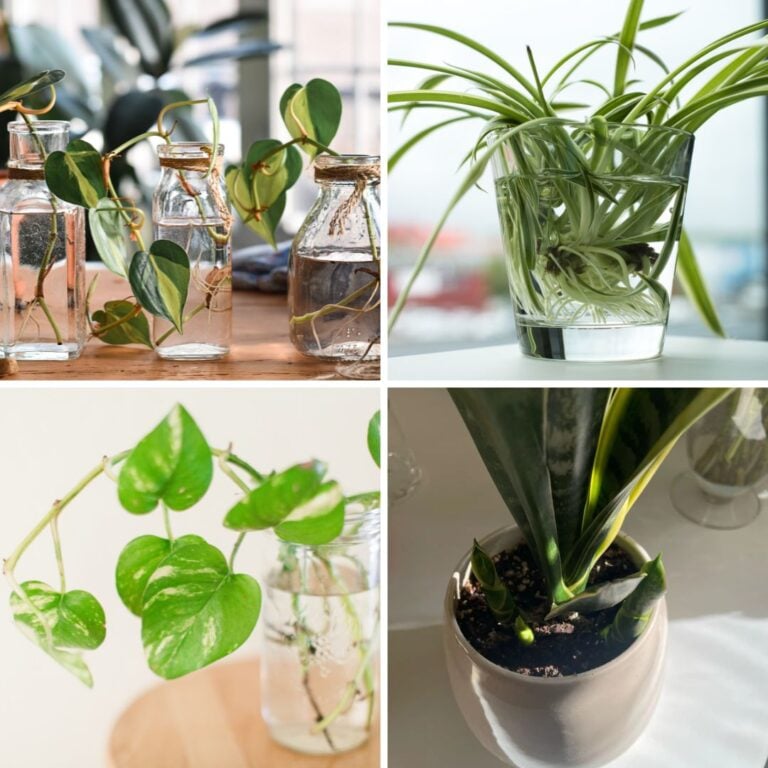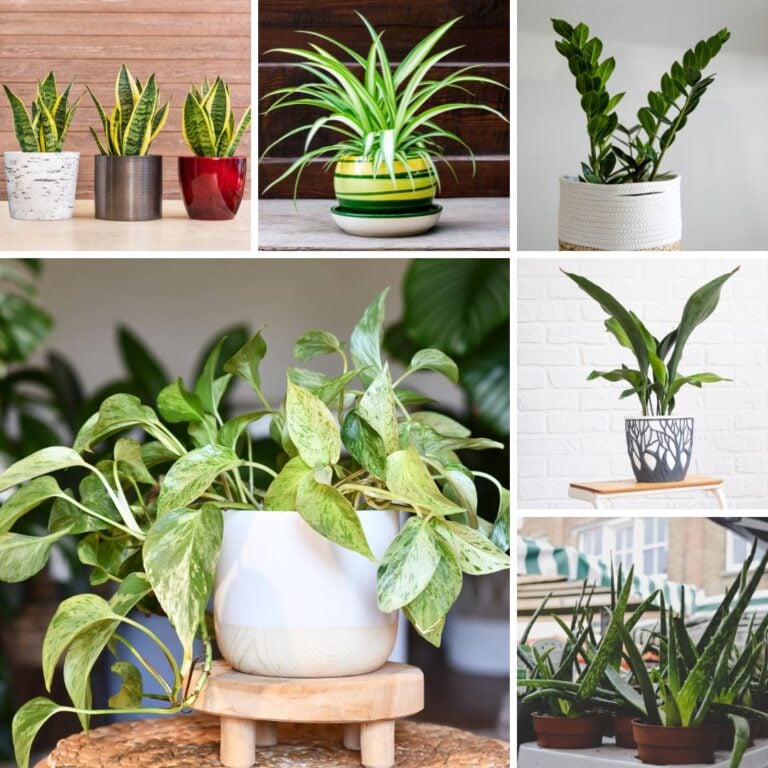10 Indoor Plants That Grow Faster in Summer Heat
I just love watching my indoor plants take off when the weather warms up. There’s something about summer heat that really makes some houseplants grow faster and look even more vibrant.
When I pick the right plants, I get a burst of fresh green growth in the summer months. It’s such an easy way to liven up any room and bring a bit of the outdoors inside.
Please note: Simplify Plants is reader-supported. Some links in the post are affiliate links and I get a commission from purchases made through links in the post.
1) Spider Plant
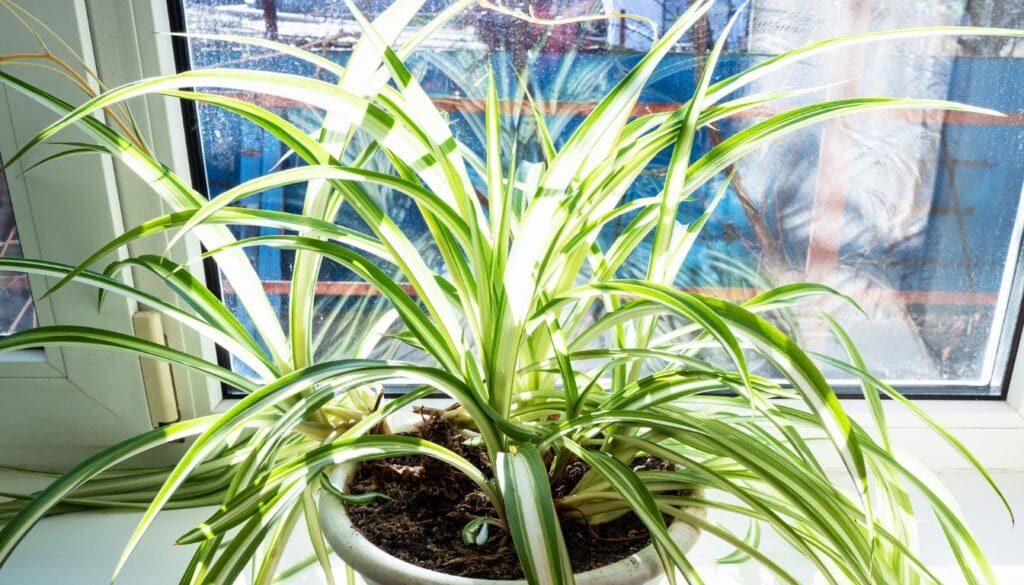
Spider Plants are just so easy to care for. Their long, green-and-white leaves always look cheerful.
These plants really don’t mind the heat. In fact, I’ve noticed they grow faster in warm, bright rooms all summer long.
I usually give mine indirect sunlight and water only when the top soil feels dry. Direct sun isn’t a friend—those leaves can scorch if I’m not careful.
The best part? My Spider Plant keeps popping out new leaves and those adorable baby shoots when it’s hot.
They seem to appreciate a bit of humidity. If the air feels dry, I’ll mist the leaves now and then.
Spider Plants are also known to clean the air, which is a nice little bonus if you ask me.
If it gets too big, I just snip off the older leaves. Watching all the new growth in summer is honestly kind of satisfying.
2) Pothos

Pothos is probably my go-to for a low-maintenance plant. It’s just so easy to keep happy, and it really speeds up its growth when summer rolls around.
The heart-shaped leaves come in green, yellow, or white. I’ve kept mine on shelves, in hanging baskets, even just in a jar of water.
Warmth in summer helps Pothos put out new leaves and stretch those vines fast. I swear, every week there’s something new.
It seems happiest if temps stay above 65°F. I like to give it bright, indirect light—too much sun and the leaves can get crispy.
When I water, I let the top inch of soil dry out first. That’s helped me avoid root rot.
Wiping the leaves every so often keeps them shiny and dust-free. Plus, Pothos helps filter indoor air, which is always a plus.
Watching the vines trail off a shelf or climb a pole is just plain fun. If you want a plant that grows fast with little fuss, Pothos is a winner.
3) Snake Plant

Snake Plants, or Sansevieria, are honestly some of the easiest plants around. Their tall, sword-like leaves always look sharp.
In summer, I see new leaves popping up more often. Warmth and a bit of extra sunlight really get them going.
I only water when the top inch of soil feels dry—overwatering is a quick way to get root rot, so I’m careful. A little fertilizer once or twice in summer is plenty.
They can handle low light, but they really perk up in bright, indirect sunlight. I usually move mine closer to a window when it’s hot out.
Snake Plants are also known for cleaning the air. I rarely have to trim them since the leaves are so tough.
If you want a plant that’s hard to kill and grows faster in summer, Snake Plant is a solid pick.
4) Aloe Vera

Aloe vera is a classic for warm weather. I’ve noticed it really takes off when summer heat kicks in.
If I keep it by a sunny window, the leaves get thick and long. It barely needs any water—just a drink when the soil is dry.
Aloe likes well-draining soil and a pot with drainage holes. Soggy roots are a no-go.
One thing I love is how forgiving Aloe is. Even if I forget about it for a week, it’s still happy.
In summer, I see new shoots (or “pups”) popping up at the base. That’s always a good sign.
Sometimes I’ll cut a leaf to use the gel for my skin—having fresh aloe on hand is super handy.
I keep mine away from cold air and drafts, especially in summer. With just a bit of care, Aloe vera stays lively and green.
5) Philodendron

Philodendrons always seem to thrive in my home, especially as the days get longer and warmer.
They love warm, humid air and really respond to bright, indirect sunlight. I keep mine near a window with filtered light.
I let the soil dry out a bit before watering. Sitting in water is a no-no for these guys.
When summer hits, new leaves seem to appear every week. Watching them uncurl is oddly satisfying.
There are so many types of Philodendrons—some with heart-shaped leaves, others with split or wavy edges. I like mixing up the varieties for more color and texture.
If my plant starts stretching or the leaves look dull, I move it a bit closer to the light. Usually, that does the trick.
A monthly dose of liquid fertilizer helps them grow even faster in summer.
Philodendrons are beginner-friendly, require little trimming, and rarely get pests. That’s why they’re a top pick for me during hot months.
6) Bamboo Palm
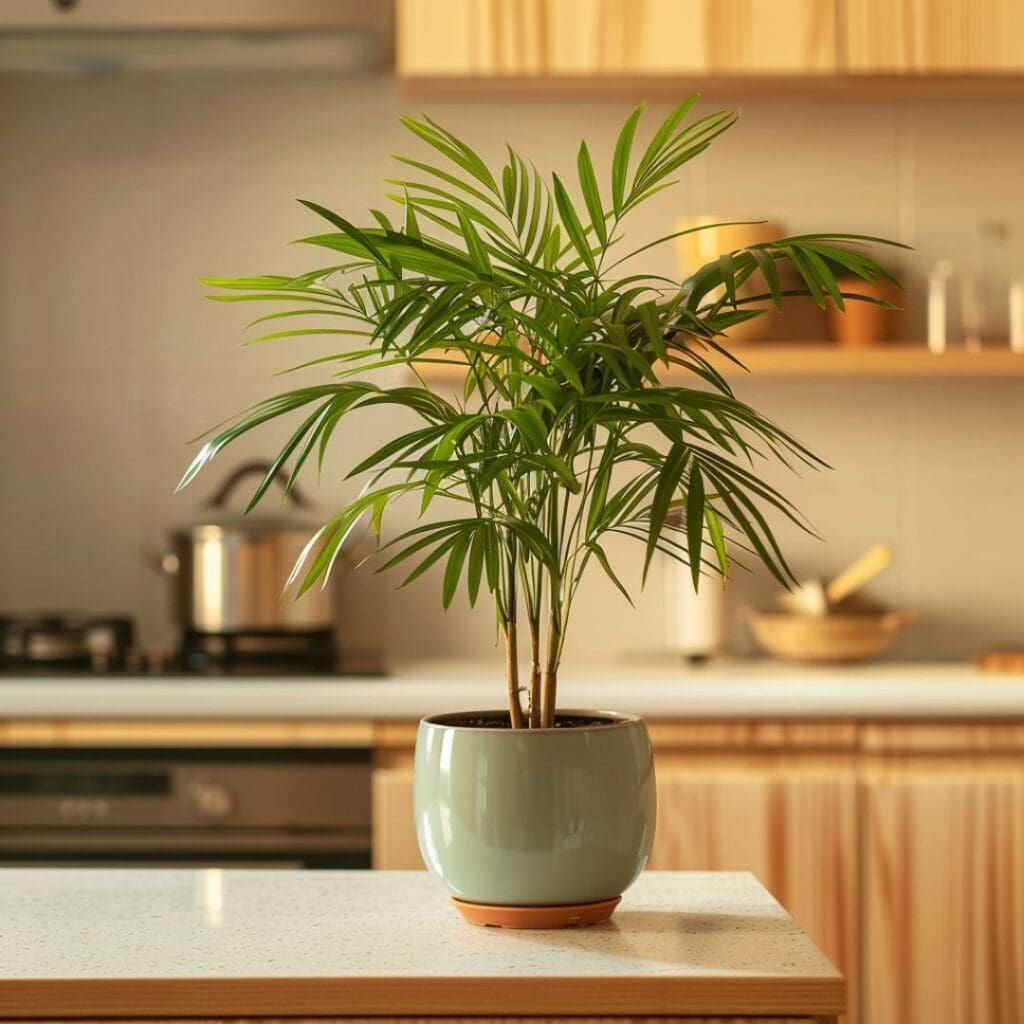
The Bamboo Palm brings a little tropical vibe to my living room. Those tall, feathery leaves are just lovely.
During summer, it really picks up speed. Longer, warmer days make it thrive.
I keep mine in bright, indirect light, but avoid direct sun. The soil needs to stay a bit damp, but never soggy.
Good drainage is key, so I water when the top inch feels dry. Roots sitting in water just won’t work.
I appreciate that Bamboo Palm cleans the air in my space. It also loves a little extra humidity, so I’ll mist it if things get dry.
I don’t fertilize often, but a monthly feeding in summer gives it a boost. If I spot yellow leaves, I trim them off.
Bamboo Palm is easygoing and not fussy at all. For fresh, fast-growing greenery in summer, it’s hard to beat.
7) Peace Lily

Peace Lilies always brighten up my place with their shiny green leaves and those white flowers. They’re a breeze to care for and make the air feel fresher.
In summer, I see them grow faster and sometimes get more flowers. The extra warmth and daylight really help.
They like bright, indirect light. I keep mine out of direct sun to prevent leaf burn.
When it’s hot, I check the soil every few days—if it’s dry, I water. They need more water in summer, that’s for sure.
Humidity is important for Peace Lilies. I’ll mist the leaves or set a tray of water nearby.
NASA even studied them for their air-cleaning skills, which is pretty cool.
If the leaves droop, it’s usually just thirsty. A drink perks it right up.
I use room-temperature water and feed it with a gentle fertilizer every month during the growing season.
Peace Lilies are beautiful, easygoing, and quick to grow indoors, especially in the summer heat.
8) ZZ Plant

The ZZ plant is just about the easiest houseplant I’ve ever owned. Those shiny, thick green leaves always look good—even if I forget to water for a while.
Summer heat gives the ZZ plant a growth spurt. I see new shoots and bigger leaves when days are warm and long.
I keep it in bright, indirect light so it gets enough energy but doesn’t get scorched. Watering is simple—just every couple of weeks, when the soil is dry.
I’ve learned not to overwater. That’s pretty much the only way to mess it up.
Sometimes I move it closer to a window in summer, but never in direct sun. Just a little extra light and warmth, and the ZZ plant is happy.
My favorite part? It brightens up any room with almost zero effort. For a plant that grows fast and doesn’t stress me out, ZZ is hard to beat.
9) Coleus

I love growing Coleus indoors during summer. The leaves are wild—so many colors and patterns, from green to pink, red, and yellow.
Coleus grows quickly when it’s warm. Honestly, I spot new leaves almost every week once the temperature climbs. Bright, indirect sunlight and some heat seem to make it happiest.
I keep my Coleus where it gets morning light. Too much direct sun? The colors fade or, worse, the leaves burn. I water it fairly often, but I let the top inch of soil dry out first.
Pinching off the tips of the stems makes my Coleus bushier and fuller. It just looks healthier that way. Sometimes I notice little flowers, but I usually snip those off so the plant puts energy into its leaves instead.
Coleus enjoys humidity, so I’ll mist the leaves now and then. Fertilizing every few weeks with a balanced liquid plant food seems to keep it going strong.
When roots start poking out of the pot, I know it’s time to repot. Coleus doesn’t mind moving to a bigger pot and just keeps growing. I find it pretty easy to care for, even in the heat.
Bright leaves and fast growth make Coleus an awesome pick for indoor gardens. It really brings a splash of color and a bit of fun to any room.
10) English Ivy

English Ivy is one of my favorite indoor plants. The green leaves look great, and the vines love to climb or trail off shelves.
It grows faster in summer, especially when there’s warmth and plenty of light. I keep mine near a window, but only where it gets indirect sunlight—too much sun just fries the leaves.
Watering is easy. I let the soil dry out a bit between waterings. In summer, I check more often since the soil dries up faster.
English Ivy helps clean the air, which is a nice bonus. The room just feels fresher. I’ll trim the vines now and then so they don’t get out of hand.
English Ivy is a fast grower when it’s warm. New leaves pop up all the time in summer, and it’s kind of exciting to watch it fill out. Hanging basket, regular pot—it works anywhere.
If I want more plants, I just take a cutting from a healthy vine and stick it in water. Usually, roots show up in a couple of weeks, and then it’s ready for a pot.
English Ivy does best with regular care. I feed it once a month in summer with plant food. I also keep an eye out for pests and wipe the leaves if they look dusty or buggy.
This plant stays green all year, which is honestly pretty great. Even in winter, English Ivy keeps the room from looking gloomy.
Creating the Ideal Summer Environment
When the temperature goes up, I pay closer attention to what my plants need. The right mix of humidity, warmth, and sunlight really helps them take off.
Humidity and Temperature Tips
I keep my indoor temperatures between 70–85°F (21–29°C) in summer. Most plants seem to love that range, but if it gets stuffy, I’ll crack a window or turn on a small fan.
Lots of plants want humidity around 40–60% to avoid crispy leaf tips. To boost humidity, I group plants together or set a shallow tray of water and pebbles nearby. Misting in the morning helps, but I’m careful not to overdo it—root rot is no fun.
Here’s what usually works for me:
- Keep room temperature steady.
- Use a humidifier or trays with water.
- Avoid putting plants near air conditioners or heaters.
Choosing the Right Sunlit Areas
I figure out how much sunlight each plant wants, then pick a spot with the right amount of light. East or west-facing windows are usually great. Most fast-growing plants do best in bright, indirect light.
If a plant needs more sun, I’ll move it closer to a south-facing window. For shade lovers, I just back them off a bit. I try to rotate my pots every week or so, so all sides get some light.
Here’s a quick table I use:
| Window Direction | Light Level | Best For |
|---|---|---|
| South | Bright, direct | Sun-loving plants |
| East/West | Bright, indirect | Most houseplants |
| North | Low, gentle | Shade-loving plants |
If I notice fading color or slow growth, I’ll move the plant. Sometimes it’s just trial and error, honestly.
Care and Maintenance for Fast Growth
I keep things simple for my indoor plants—healthy routines make all the difference. Watering and feeding matter most in summer.
Watering Best Practices

Consistent watering is really the secret to fast growth. I poke my finger in the top inch of soil—if it’s dry, time to water.
I use room-temperature water and pour slowly until it drains out the bottom. That way, I avoid root rot. Any extra water in the tray? I dump it so the roots don’t sit in soggy soil.
Quick tips:
- Most leafy plants need water every 3–4 days in summer.
- Succulents and cacti don’t need as much; I water those every 10–14 days.
- Soggy soil is bad news—mold and fungus love it.
When it’s hot, plants dry out quicker. I’ll mist leaves in the morning sometimes, just to keep things humid.
Feeding and Fertilization Guidance

During summer, plants burn more energy, so regular feeding helps. I go for a balanced, water-soluble fertilizer, something like 10-10-10 or 20-20-20.
I feed leafy plants every couple of weeks by mixing fertilizer into the water. If I have flowering or fruiting plants, I’ll sometimes use a bloom-booster with more phosphorus.
Feeding tips:
- I stick to the label—too much fertilizer is worse than not enough.
- I skip feeding plants that are sick or just got repotted.
- If leaves yellow or get brown tips, I flush the soil with water to clear out any extra fertilizer.
Regular feeding keeps my plants green and helps them grow stronger roots.
Frequently Asked Questions
People ask me a lot about indoor plants that love heat, need little care, or grow quickly. Some types grow fast even in low light, while others handle dry air or start easily from seeds.
What are some great indoor plants that thrive in high temperatures?
Spider Plant, Snake Plant, and Aloe Vera all do well when it’s hot inside. My Aloe Vera, especially, seems to love the summer and puts out new growth.
Can you list some indoor plants that shoot up quickly even with little light?
Pothos and Philodendron are my favorites for low-light spots. Their vines grow fast, even if they’re far from a window. Snake Plant is another solid pick for lower light.
Which plants are best suited for growing tall and rapidly indoors?
If you want something tall and fast, Philodendron and Pothos are hard to beat. They’ll climb or trail, and Spider Plant sends out long shoots you can let drape or trim.
Could you suggest indoor plants that germinate quickly from seeds?
Basil and Sunflower pop up fast indoors if you keep them warm. I’ve seen them sprout in less than a week. Cilantro is another herb that’s quick from seed.
What fast-growing plants would you recommend for a science project?
Bean plants are my go-to—they sprout and leaf out in just a few days. Sunflowers are also fun to watch, and Basil germinates super quickly.
Are there any indoor plants that prefer dry heat and still grow quickly?
Aloe Vera and Snake Plant really stand out for me. Both are champs at storing water in their leaves, so they’re totally fine with dry, warm air.
Honestly, they tend to take off when summer rolls around—as long as I remember not to go overboard with the watering.
Recommended Garden Supplies
| Product Image | Our Recommended Gardening Supplies | Check Offers! |
|---|---|---|
Top Top
Top
Top
Top
Top
Top
Top
Top | rePotme Houseplant and Tropical Classic Potting Soil Mix | Check Offer On Amazon |
 Top
Top
Top
Top
Top
Top
Top
Top | Espoma Organic Indoor Plant Food | Check Offer On Amazon |
 Top
Top
Top
Top
Top
Top
Top
Top | GooingTop LED Grow Light 6000K Full Spectrum Clip Plant Growing Lamp | Check Offer On Amazon |
 Top
Top
Top
Top
Top
Top
Top
Top | Soil Moisture Meter | Check Offer On Amazon |
 Top
Top
Top
Top
Top
Top
Top
Top | Govee Hygrometer Thermometer, Bluetooth Enabled! | Check Offer On Amazon |
 Top
Top | LEVOIT Humidifiers for Large Room(Best For Plants) | Check Offer On Amazon |
 Top
Top
Top
Top
Top
Top
Top
Top | Upgraded DIY Automatic Drip Irrigation Kit, 15 Potted Houseplants Support | Check Offer On Amazon |
 Top
Top
Top
Top
Top
Top
Top
Top | Stainless Steel Heavy Duty Gardening Tool Set | Check Offer On Amazon |
 Top
Top
Top
Top
Top
Top
Top
Top | Bonide Insecticidal Soap | Check Offer On Amazon |
 Top
Top
Top
Top
Top
Top
Top
Top | Bonide 32 oz Spray Neem Oil for Organic Gardening | Check Offer On Amazon |
 Top
Top
Top
Top
Top
Top
Top
Top | Garden Safe Fungicide | Check Offer On Amazon |

